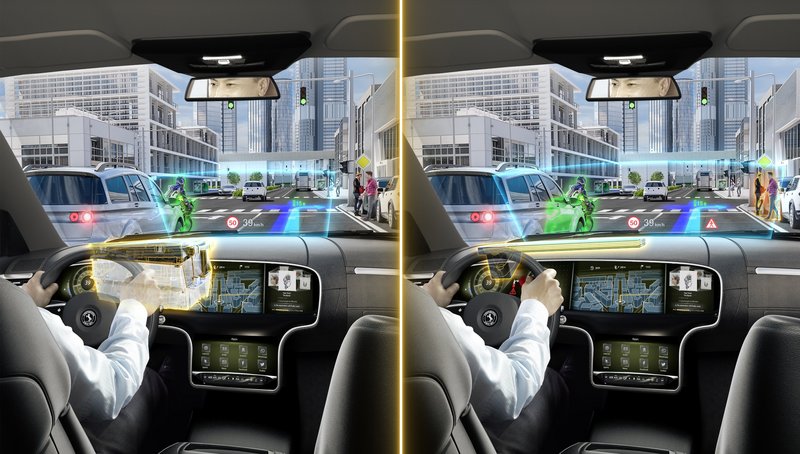Cutting-Edge technology Powers Continental’s Augmented Reality Head-up Display
- Despite an ultra-compact design, the new waveguide technology enables large-area augmentation in the driver’s field of view
- Shifting from mirrors to innovative waveguide technology makes it possible to integrate an AR-HUD in many vehicle cockpits for the first time
- Continental builds a full-color demonstrator to show the ultra-compact waveguide HUD’s potential
Babenhausen (Germany), October 10, 2018. The technology company Continental reveals an industry-first full-color demonstrator of an automotive-specific Head-up Display (HUD) based on waveguide technology. This demonstrator is the result of the joint development with DigiLens Inc., one of the leading experts in projection technology enabled by switchable holographic gratings.
“Head-up Displays, particularly those with large-area augmentation, provide optimum driver support. Thanks to our early investment into waveguide technology, we are now taking a big step forward towards ultra-compact AR-HUDs. We have successfully overcome the most challenging hurdle which is the instrument size. As a result, industrializing the AR-HUD in the vehicle is now within reach,” said Dr. Frank Rabe, Head of the Continental business unit Instrumentation & Driver HMI.
HUDs with graphic augmentations in a real-world view offer intuitive driver support. Embedding the augmentations in the real world makes the driver immediately understand where their attention is required and why. For instance, virtual turn-by-turn navigation signs on the road make driving safer and easier. During automated driving, an AR-HUD can make the vehicle’s “sensing” and “planning” transparent. As an AR-HUD requires the option to embed augmentations in the complete forward field of view of the driver, the use of mirrors inside the instrument, which is state-of-the-art today, leads to AR-HUD instrument volumes of around 30 liters – too much for most dashboards.
The new Continental AR-HUD with waveguide technology significantly reduces the packaging size. With this new, innovative technology, Continental achieves an augmentation area of 15° x 5° (= 2,60 meters x 0,87 meters at a projection distance of 10 meters) while bringing down device size to a mere 10 liters magnitude. At that level, device integration becomes possible in many vehicles.
Flat waveguides replace mirror technology
Up until very recently, AR-HUD development was still generally based on mirror technology, like in the windscreen HUD. However, what works well in the HUD is not an option for the AR-HUD, because the display area of a conventional HUD is small by comparison.
While a conventional windscreen HUD has a volume of 3 to 4 liters, mirror technology inevitably leads to spatial AR-HUD capacities that can be around 30 liters, which is almost ten times as much.
“Most vehicles simply do not offer this amount of space. That was clear from day one, and that is why we wanted a different solution in order to be able to offer the AR-HUD benefits to as many drivers as possible,” said Dr. Pablo Richter, Principal Expert Optical Technologies at Continental.
That is also why Continental entered into a strategic partnership with the waveguide HUD expert DigiLens, located in Silicon Valley, in 2016 and increased this participation in 2018. The joint development work has now produced the first full-color demonstrator, which uses three flat waveguides stacked over one another to create the RGB color space – and no mirrors.
“The light rays from the projector enter the multi-layer waveguide from underneath. They get folded inside the waveguide and are finally projected upwards to create the virtual image through reflection on the windscreen,” Richter explained. “One of the many challenges was that while our development partner had produced solutions for the helmet visors of pilots or motorcycle drivers, the large-area application to a windscreen takes the technology to a whole different dimension.”
Continental´s demonstrator enables augmentations within a field of 2,60 meters x 0,87 meters at a projection distance of 10 meters and solves the previous size issue of the AR-HUD. Over the course of ongoing development, further necessary requirements to the vehicle application will be met individually.

Alena Liebram
Media Spokesperson Automotive Aftermarket, Continental Engineering Services and Technology Organization
Continental Automotive



